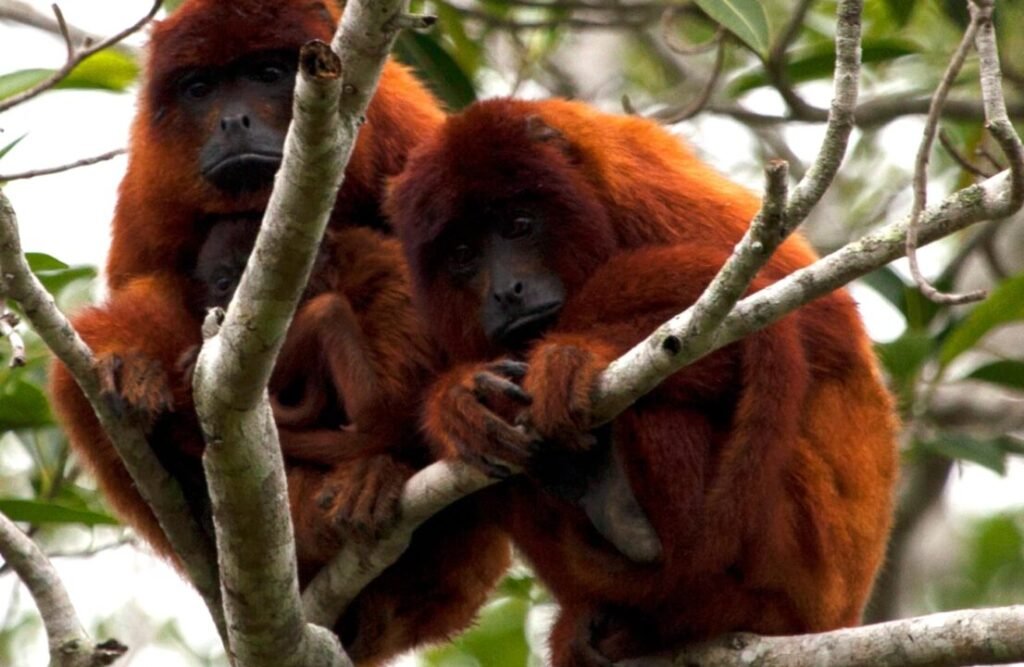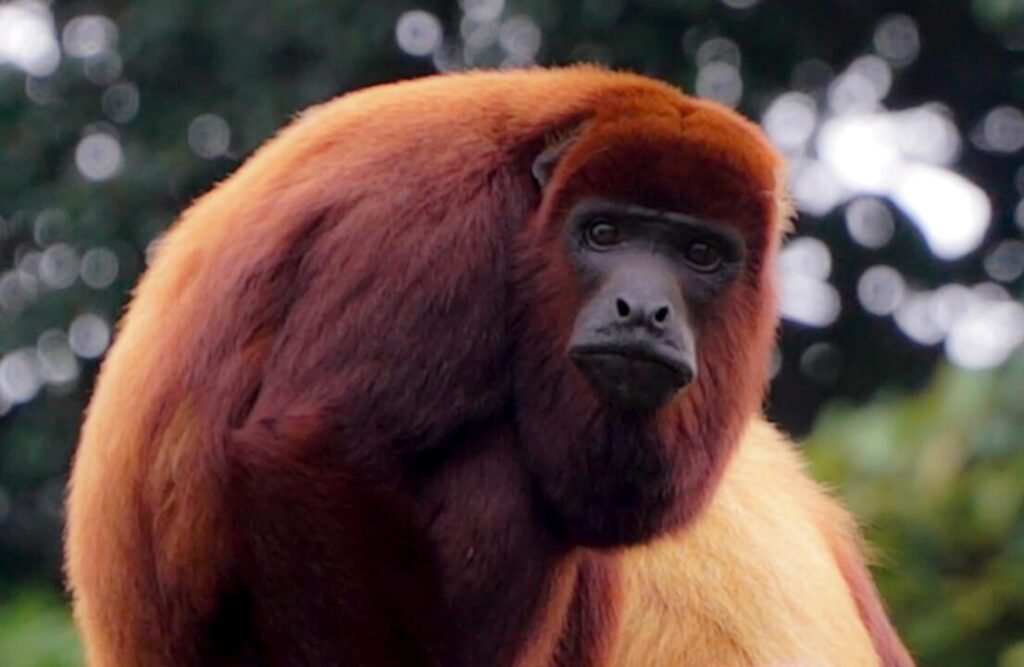The red howler monkey, Alouatta seniculus, is one of the largest primates in Peruvian’s Amazon.
Howler monkeys, the largest and strongest monkeys in all of America, measure between 56 and 92 cm in length not counting their tail. They use their tail to grip branches when moving around, which is why it is called a prehensile tail. They can weigh 8 kg on average.
Their fur is lush and fiery red in color covering almost their entire body. They have a large black beard that allows them to recognize each other well. Their feet, hands and face are black and have no fur there. Their name comes from the fact that they can produce one of the loudest sounds among all land animals, as they have a large cavity in their throat that serves as a resonance chamber and allows their howl to be heard up to 5 km away.
(Hear a Red Howler Monkey Roar in the video below)
Diet
The diet of howler monkeys is primarily herbivorous with a tendency to consume leaves and ripe fruits. They also eat flowers, petioles, roots of epiphytes, orchid bulbs, tender branches and terminal shoots of young lianas. Fruit consumption can vary with seasonality, and they may be highly frugivorous during times of greater supply.
Howler monkeys were already described by the renowned naturalist Linnaeus in 1766. They are present in the northwestern part of South America, in the Amazon region of Colombia, Ecuador, northern and eastern Peru and Venezuela. They live mainly in lowland forests, whether deciduous and dry, gallery, cloud, várzea or mangrove forests. Although they can develop at higher elevations, they are more common below 700 FASL.
Their main enemies are harpy eagles, although they do not have many natural predators. They are one of the few primates that are listed as “Least Concern” on the Red List of Threatened Species and are only very occasionally hunted for food in Colombia.
Red Howler Monkeys’ Behavior
Howler monkeys live in groups, which normally consist of around 6 individuals, but can reach up to 16, dispersed over very large areas, from 4 hectares to as much as 182 hectares. They move around on all fours, although 20% of the time they walk upright. They spend most of their time sleeping, then eating, and then moving. Their activities are diurnal and tend to vary by season: when it does not rain, they rest more and move less, and when it rains, they do the opposite. They live in trees, especially the larger ones.
Each day they can travel between half a kilometer and one and a half kilometers, approximately, helping to disperse seeds. The name “howler” is no coincidence: they have a bone, the hyoid, that is responsible for greatly amplifying the sounds they make when vocalizing, aided by their strong jaw. Between groups they communicate using these sustained vocalizations, although sometimes the howls provoke direct contact intended for grooming. This appears especially among mature and young females, but also in males that are not yet fully adults. Howler monkeys vocalize loudly to mark territory, attract mates, and respond to environmental disturbances. They have a wide range of vocalizations, from whimpering to roaring.
Likewise, there is grooming within the group members towards each other, depending on age, social situations and sex, with great variation between different groups. In general, however, adult females do the most grooming of others, which is common among closely related monkeys. According to biologists, since grooming occurs in areas of the body that monkeys cannot access themselves, it is related to hygiene.

Where Can I Find them?
The Red howler monkey is found in the eastern region of the Peruvian territory, particularly, at Tambopata’s National Reserve in Puerto Maldonado. They can live at all altitudinal levels of the mountain ranges up to 700 FASL and rarely up to 950 ft.
They are found in the dry lowland forests as well as mountain forests and guadua bamboo forests. This means they can inhabit primary, secondary and intermediate forests. This also applyes to various states of conservation, helping to guarantee the future survival of their populations.
Howler monkeys need large trees supporting interconnected branches to move freely in forest canopies.

Reproduction
Older adult male howler monkeys have exclusive mating rights with group females. Each time, the females give birth to one offspring, without there being a specific breeding season. The young are raised by all the females of each troop. Only in extraordinary situations does an outside male arrive, stage a “coup d’etat” and kill the infants.
Normally, when they reach adulthood, the females join with other outsiders to find new groups, thus avoiding the inbreeding of detrimental genetic consequences. Males survive up to 5 and a half years, females one year less; upon reaching adulthood, the males also leave their family to join a new one.
The female sexual cycle lasts about 17 days, which the males can detect by scent. The infants are very vulnerable, because the prehensile tail does not become useful until two months old, so at first they cling to their mother’s belly until they can climb onto her back.
Conclusion
These intriguing species are part of the denominated “New World Monkeys”. Their pressence is spreaded throughout the Southamerican Amazon region and one’s able to get a glimpse of them in Tambopata’s Reserve.
Peru Jungle Trips is always attentive for your requests of information to travel to the Peruvian Amazon. Contact us today and begin with your vacations planning!

